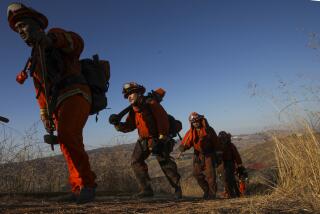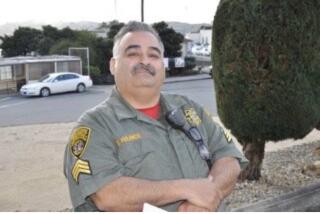San Quentin’s Neighbors Fear Protests
SAN QUENTIN — The small residential community of clapboard houses and condominiums flanks a narrow street that dead-ends right at the swinging iron gates of San Quentin Prison.
Most residents of San Quentin Village don’t mind living in the shadow of the prison because it is one of the few spots left in the Bay Area with waterfront property at affordable prices. Security at the prison is excellent, residents say, and they rarely worry about having 5,000 assorted rapists, murderers and burglars as neighbors.
But now, for the first time, they live in fear, in fear of the thousands of demonstrators who are expected to descend on the village before next month’s scheduled execution of Robert Alton Harris.
“We don’t mind the prison . . . it’s the demonstrators who are going to destroy this village,” said Pat Orr, president of the San Quentin Village Assn., who lives about 100 yards from the prison entrance. “These mobs will be trampling our lawns and keeping us awake three or four nights in a row. This little street is going to bear the brunt of the whole damn death penalty issue in California.”
Some Marin County officials say they will soon ask the state to build a gas chamber at a state prison in a more remote location. San Quentin is particularly ill-suited as the site for the state’s only gas chamber, officials say, because the prison is next to the village and is less than a mile from three other Marin County cities.
With 278 men on death row, county residents fear that the Harris execution will usher in a wave of executions. Frequent executions could create chronic problems in Marin County and subject the area to much unwanted attention.
“Nobody wants to live in the execution capital of the state,” said Ann Cymerys, who lives down the street from the prison. “Instead of hot tubs, pretty soon the symbol of Marin County is going to be the gas chamber.”
Up to 3,000 demonstrators are expected at next month’s execution, according to Sheriff’s Department estimates, and the cost for law enforcement alone will be several hundred thousand dollars. Preparing for the Harris execution has been a burden on the county; preparing for dozens of others, officials said, would be intolerable.
“We’re not talking about a few hundred people singing ‘We Shall Overcome’. . . . Tremendous crowds are expected,” said Marin County Supervisor Gary Giacomini. “We’re simply not going to go through this 278 times in Marin County. . . . If we have to file litigation to have the gas chamber moved, we will.”
In San Quentin Village, the turn-of-the-century houses, Victorians and a small condominium project line Main Street, which is only about half a mile long and extremely narrow. The street will be overflowing before the execution, law enforcement officials predicted, with demonstrators spilling onto the front yards of residents. Giacomini characterized the upcoming demonstration as “a disaster in a cul-de-sac.”
Ann Cymerys has grown accustomed to living in the shadow of San Quentin. On a warm, crystalline day, she stood on the deck of her home, on a bluff above Main Street, and enjoyed the sweeping view. The bay lapped against the shore beneath her house, and in the distance she could see a blue and white ferry steaming toward San Francisco, the graceful arch of the Bay Bridge, and to her right, only a few hundred yards away, the pale-yellow granite walls and gun towers of San Quentin Prison.
Most of the time the prison is quiet, Cymerys said, and she forgets it’s there. But she is jolted back to reality when she sees a man, smiling broadly, carrying a Manila folder, jauntily walking away from the prison after his release; or when she hears the 4 p.m. prison bell for the daily count, or when she sees a Sheriff’s Department bus filled with prisoners rumbling down Main Street toward the front gate.
She felt threatened for the first time about six months ago when the prison sounded an alarm, guards searched the shore with guns drawn and helicopters with searchlights buzzed the neighborhood. She later discovered that no convicts had escaped from the prison, but two burglars mistakenly had broken into the prison. They had been caught breaking into cars at the nearby Larkspur Ferry parking lot and, attempting to elude police, scaled a fence at a minimum-security section of the prison.
“With all the guards and security, I feel safe here,” said Cymerys, who lives in a renovated Victorian with her husband and small son. “The one thing that really concerns all of us is the prospect of having to endure demonstrations over and over again. We’re not saying we don’t want any executions in our back yard; we’re saying we don’t want every execution in our back yard. Why can’t some of those prisons in more remote areas share some of the burden.”
Residents of the village might be disturbed by the demonstrators, but at least they won’t have to worry about the gas chamber polluting their neighborhood. An environmental impact report prepared for San Quentin by a consulting firm concluded that the lethal vapors created by cyanide pellets dropped in acid wouldn’t endanger nearby residents. The report concluded that the gas dissipates to a harmless level by the time it is released into the atmosphere through a copper stack that rises 18 feet above death row.
As in other communities across the state, residents of the village have varied views on capital punishment. Some say Harris deserves to be executed but don’t think it is equitable that their community bear the brunt of this execution and every other execution that follows.
The communities of San Rafael, Larkspur and Corte Madera, which are less than a mile from the prison, also are worried about large-scale demonstrations. Some city officials say that if the demonstration becomes unruly, highways and heavily traveled roads could be closed, creating massive traffic problems. Interstate 580, a major commuter route from Marin County to the East Bay, is only a mile from the main gate, and a busy city street runs beside the back entrance to the prison.
Prison officials set the execution time at 3 a.m. to avoid commuter gridlock, but there is concern that demonstrators might linger several hours after the execution and disrupt rush-hour traffic.
“If 2,000 people show up, they’ll be packed all the way from the main gate to 580,” said Marin County Sheriff’s Lt. Bill Donovan. “We hope it doesn’t come to that, but we have contingency plans set up in case 580 and other roads are closed.”
Executions at prisons in more remote areas such as Avenal State Prison in the San Joaquin Valley or Pelican Bay State Prison in Crescent City would be less disruptive, Marin residents say. In 1987, the state Department of Corrections discussed holding executions at other sites, but then decided not to make any changes, spokeswoman Christine May said. The department didn’t want to bear the cost of building another gas chamber or relocating Death Row, she said. And because the prison is near San Francisco, inmates have easier access to legal counsel and the courts than they would in a rural area.
Bob Mitchell, mayor of Sausalito, which is 12 miles from San Quentin, is concerned about the psychological impact of frequent executions in Marin County. Even though the crowds may diminish after the first execution, Mitchell said, the other executions will still attract some demonstrators and coverage in the local media.
“Repeated, ongoing executions is not something you want your kids exposed to,” Mitchell said. “You worry about violence on television desensitizing kids to violence. Wholesale executions in your county could have the same effect.”
The last execution in the state was in 1967 when Aaron Mitchell, who killed a Sacramento policeman, died in San Quentin’s gas chamber. The night before, about 300 people crowded into San Quentin Village to demonstrate. Ten times that amount are expected for next month’s execution, according to Sheriff’s Department estimates.
“The street seemed crowded with protesters--a real mess--during the last execution. . . . I hate to see what this one’s going to be like,” said Mignon Detmayer, who has lived near the prison’s main gate for 35 years.
The demonstrators were “well-behaved” and spent the night before the 10 a.m. execution singing and praying during a candlelight vigil, recalled Lt. Donovan, who as a young deputy worked crowd control that night. But then American Nazi Party chief George Lincoln Rockwell and a few of his followers arrived, carrying racist placards.
“A little disturbance broke out, but we got him out of there before it got out of control,” Donovan said. “Besides the Rockwell thing, it was very peaceful and an hour after the execution everyone was gone. But it’s a different world today. There’s more anti-death penalty groups now and they’re better organized. We’re anticipating something much bigger this time.”
More to Read
Sign up for Essential California
The most important California stories and recommendations in your inbox every morning.
You may occasionally receive promotional content from the Los Angeles Times.










